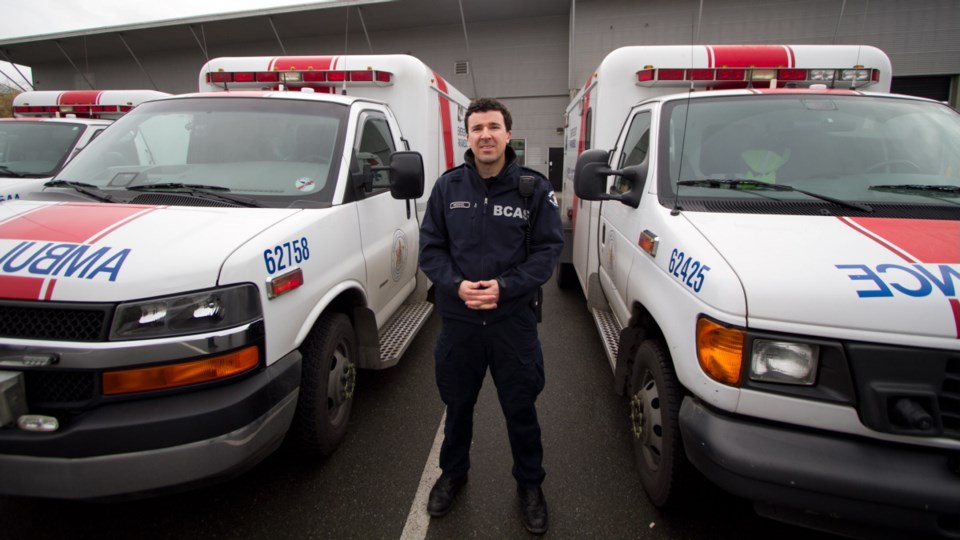Telling someone their loved one has died is the toughest task Victoria paramedic Michael Lowey has to perform.
“It’s always a terrible, uncomfortable situation,” said Lowey, a 10-year paramedic. “You want to say something, but we never really learned what.”
The B.C. Ambulance Service has developed a new course to help paramedics understand, appreciate and better manage the “experience” of giving notice of death. It took about one year to develop and was rolled out in September.
Don Hong, a 32-year paramedic with the B.C. Ambulance Authority and now an educator, said the service has created a four-hour instruction and workshop-based program that gets to the emotions of death notification, for paramedics as well as the people notified.
Hong said it’s important for paramedics to recognize that the grieving process is an essential emotional experience — a health matter. And the grieving process begins at the notification of death.
“The family members, the friends of the individual, they are going to remember this for the rest of their lives,” he said. “They are going to remember the time of day, the smells, the sounds outside.
“What you do in those first few minutes can make or break how they will deal with the entire event,” said Hong. “It’s a tragedy, but you can make the best of that.”
Hong said paramedics, like all health-care workers, nurses and doctors, are expected to take courses to upgrade technical, medical skills.
But paramedics have never had any formal instruction in dealing with the emotions around informing a person that someone close has died. They learned it on the job from colleagues. Hong said he looked all over North America and found nothing “that actually touched on the experience of giving a death notice.”
Since launching the death notification course, the B.C. Ambulance Service has taken inquiries from other provinces, as well as from the U.S., including Texas and California.
Hong said the course became especially necessary after 2006, when studies and evidence changed the way paramedics handled critical events, such as heart attacks.
Previously, he said paramedics would load a patient into an ambulance and head to an emergency department as fast as possible — “load and go.”
But evidence in recent years has shown results are better if the paramedic handles actions such as resuscitation efforts at the scene. So the B.C. Ambulance Service has moved with the new evidence and now leaves paramedics at the scene longer to assist patients.
This shift in procedures means paramedics are also on the scene for more deaths. And where emergency-room doctors might have previously given the notice of death, it can now be handled by a paramedic.
One of the first things paramedics had to learn was to shift their healing energy. Once a patient has died, the nearby relative — a spouse, for example — now needs assistance.
“Then they become the patient,” Hong said.
He said he has learned to humanize himself, remove his stethoscope, turn down the dispatch radio. He will find a quiet place, maybe even the ambulance, to tell someone that their loved one has died.
One of the most common questions paramedics ask during the course is: “What should be done with the silence?”
“You have given the death notification and there is this uneasy quietness,” said Hong. “Should we try to fill that in?”
“The answer to that is no. You are just there to help this person process the information,” he said.
A person may ask, and will be granted, a chance to see the body, with some warnings if injuries are catastrophic. Hong said he asks and allows people to be in the room when he is working to revive a person.
These things can help a person mentally deal with the death. They better accept that someone close has died. And they don’t wonder if anything more could have been done, he said.
Paramedics are also taught to recognize that this experience will also take a toll on themselves. Therefore, they need to watch out for signs of emotional distress in themselves and their colleagues.
“You walk away from these things and you can feel exhausted,” Hong said. “We want to make sure the paramedics realize they take away a bit of this.”
He said the most powerful element of the course almost didn’t make it in.
Instructors would take paramedics through a scenario, ending with the notification of death. The class is then split into pairs for role play. One person becomes a paramedic delivering a death notification, the other a close relative of the deceased.
The result was almost overwhelming. People in the class broke down in tears or became speechless with discomfort, Hong said.
“I looked at it and said, ‘;You know, I don’t know if we should be doing this, it’s too extreme,’ ” he said.
“And the class actually came back to me and said, ‘;No, keep it in.’ They said ‘;Even though it is just a scenario, we are experiencing these emotions in a safe environment and now we can discuss them.’ ”
Lowey said taking the course has given him a better understanding of delivering the terrible news.
“It’s so important,” he said. “We have been looking for something like this for a long time.”



